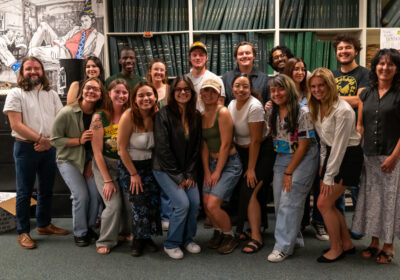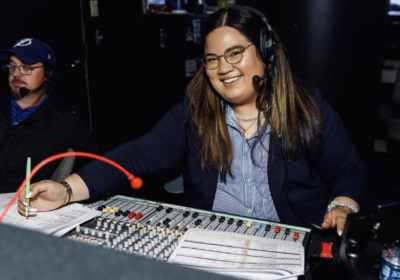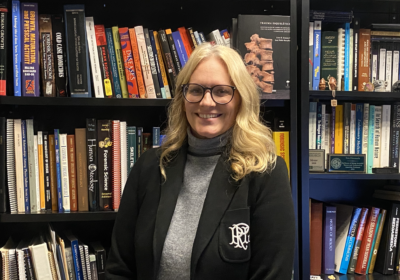Science inspired art collection growing on campus

Science-based art has been a staple on campus for decades with the newest installation being Caelum Dust by Tomas Saraceno.
ORACLE PHOTO/MIKI SHINE
The fields of art and science aren’t commonly viewed as interconnected. However, multiple sculptures on campus attempt to bring these two fields together.
The latest addition to scientifically inspired art on campus was installed in the Interdisciplinary Sciences Building. These three multisided spheres of iridescent colors hang above the atrium of the building while suspended by black strands.
The piece, Caelum Dust, is said to represent a bridge between disciplines while resembling nucleuses, neuron networks or spider webs.
“This artist and this work was chosen to reflect the Interdisciplinary Sciences Building,” said Sarah Howard, Curator of Public Art and Social Practice.
Caelum Dust is by artist Tomas Saraceno who was born in Argentina and now lives in Berlin. Saraceno was selected to create a piece for USF by a committee of visual arts experts, the building’s architect, the university’s facilities project manager and members of the Interdisciplinary Science faculty, according to Howard.
The project was funded by Florida’s Art in State Buildings program, which requires one-half of 1 percent of a construction budget go towards producing public art for the building or the surrounding area.
This isn’t the first piece on campus to reflect a merge between science and art.
Unspecified Gravity, a piece housed near the chemistry building, depicts water molecules in the middle of a fountain. The Mickey Mouse head shaped figures illustrate the hydrogen and two oxygen atoms bound together to create a water molecule.
“That’s another interdisciplinary project that can be interpreted in many ways,” Howard said.
The piece by Doug Hollis was installed in 1997 and uses stainless steel along with chromed copper to reflect light off of the pool below.
Also in the surrounding greenery is a series of functional seats with depictions of different elements from the periodic table on them.
Another piece students might recognize is the Solar Rotary near Cooper Hall. This tall aluminum sun-shaped piece is designed to mark the summer solstice along with important dates in Florida and Tampa history.
According to Howard, the art works as a time piece with the sun’s shadow casting on different markers around the courtyard that highlight different historical events over the course of a year.
In 1995, the artist Nancy Holt employed the help of USF faculty across different fields in order to make this piece achieve its intended goal.
The historical events include March 27, 1513 when Florida was first sighted, Aug. 14, 1772 when the first map of the Florida coast was completed and Sept. 5, 1958 when the groundbreaking ceremony for USF took place.
“It incorporates history, solar phenomenon, astronomy,” Howard said. “It really taps into different faculty on campus who contributed to the research necessary to figure out the engineering of that.”
Saraceno’s work in the Interdisciplinary Sciences Building only adds to the collection of multifaceted pieces around campus.
“This is a very important piece to add to our collection by a very prominent artist working internationally and we’re very fortunate to have it on our campus,” Howard said.







